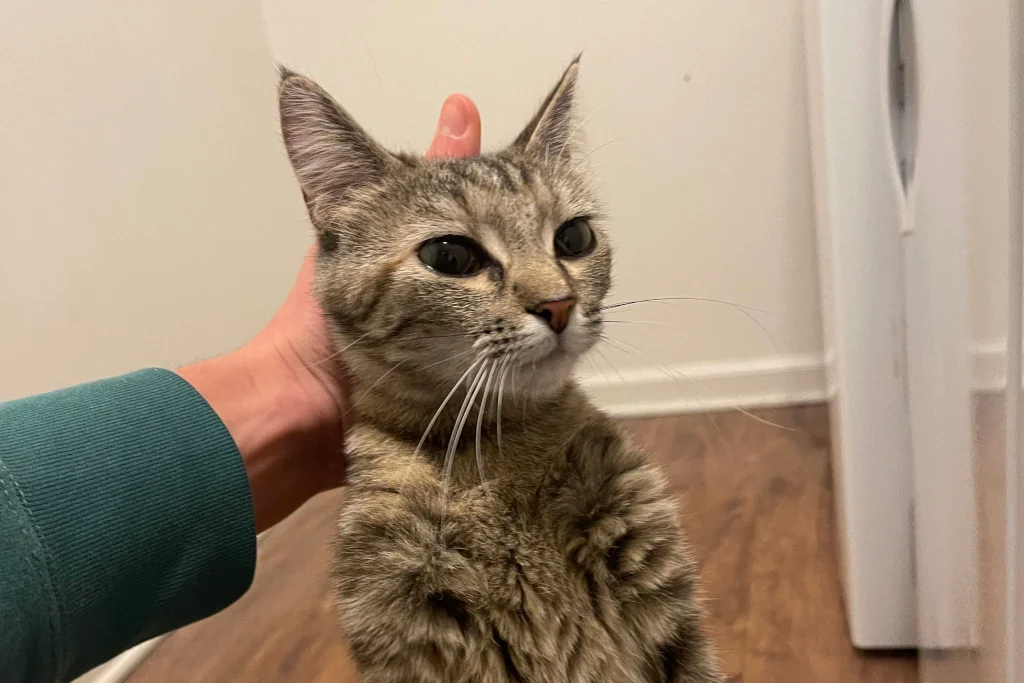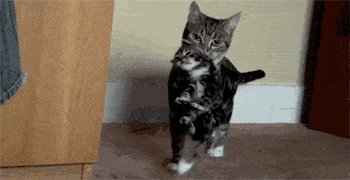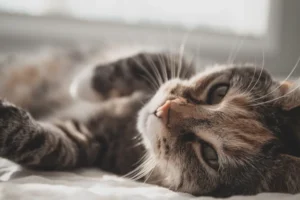Disclosure: We may earn a commission from helpful, relevant links in our content. No cost to you. See our privacy policy.
Ever wondered why your furry friend seems to freeze when you grab the scruff of their neck? It’s a common question that leaves many cat parents puzzled and even a bit concerned.
Unveiling the mysteries of your cat’s behavior can bring you closer to understanding your pet and fostering a deeper bond. Now, let’s dig deeper and explore the whys and hows of this intriguing phenomenon.

What Happens When You Grab a Cat by the Scruff?
Grabbing a cat by the scruff mimics how a mother cat carries her kittens. When a mother cat does this, she’s taking her kitten to safety, so the kitten instinctively goes limp, enabling easier transport.
This instinctive response is called ‘tonic immobility’ or ‘clipnosis’ and is quite common in the animal kingdom.
The proper scientific term is ‘pinch-induced behavioral inhibition’ (PIBI) and is more than an interesting peculiarity. It’s an ingrained survival mechanism crucial for wild cats.
This behavior is not limited to cats. Rodents, rabbits, guinea pigs, and dogs also show immobilization when restrained in certain ways, often referred to as ‘animal hypnosis’. But interestingly, PIBI isn’t universal in all cats. Not all felines are susceptible and the effectiveness varies, yet for most, it provides a method of gentle restraint.
Remember, though, this is more than just an interesting behavior; it’s a built-in survival mechanism that serves a crucial purpose for cats in the wild.
Does Holding a Cat by Its Neck Paralyze Them?
Let’s clarify: grabbing a cat by its scruff doesn’t cause paralysis in the typical sense.
Paralysis is the loss of muscle function in part of your body, typically due to nerve damage, which isn’t the case here. What happens when you scruff a cat is a behavior called ‘tonic immobility,’ a temporary and reversible state of inactivity.
It’s a response to being carried by their mother or, in some cases, the sensation of being held by a predator. This can be helpful for a vet to keep a cat still, but for us cat parents, it’s essential to understand when it’s appropriate and how to do it safely if needed.

Is Scruffing a Kitten Different From Scruffing an Adult Cat?
Yes, scruffing a kitten is quite different from scruffing an adult cat. This might come as a surprise to many cat owners.
Kittens have a stronger ‘tonic immobility’ response because mother cats often move them around by the scruff when they are young. However, as a cat grows and gains weight, being held by the scruff can become uncomfortable and even harmful.
You see, an adult cat’s body is much heavier than a kitten’s, and the scruff isn’t designed to support all that weight. It’s somewhat akin to you wearing a backpack that’s too heavy for a single strap to handle.
This important nuance in handling cats is frequently missed by many blogs and articles, leading to misconceptions and potentially harmful practices.
Does Scruffing a Cat Cause Them Pain?
Whether scruffing causes pain to a cat depends on how it’s done and the individual cat’s tolerance.
Lightly holding the scruff may not cause discomfort, but lifting or dragging an adult cat by the scruff certainly can. It’s crucial to remember that what was tolerable as a kitten may not be as an adult cat. If done improperly or unnecessarily, scruffing can lead to stress, fear, and even physical injury.
Some cats may also associate the scruffing action with negative experiences, leading to fear or mistrust. That’s why it’s recommended to use gentler handling methods unless it’s absolutely necessary and only then if you’ve been shown the correct technique by a professional.
One often-overlooked fact is that cats communicate their discomfort subtly. Watch out for signs like flattened ears, dilated pupils, or twitching tails, as these can indicate your feline friend is not enjoying the experience.
As with any interaction with your pet, empathy, respect, and understanding are key to a strong bond.
Better Alternatives to Grabbing a Cat by the Neck
Learning how to handle your cat without resorting to scruffing is a vital aspect of feline care
An often-recommended alternative is the “scoop-and-cradle” technique. This involves gently scooping the cat up with one hand under its front legs and the other supporting its hind legs and bottom, similar to how you might hold a small child. This method distributes the cat’s weight evenly and creates less discomfort.
Here’s a great video on how to do scoop a cat properly:
Another useful tip is using a soft towel or a cat carrier when you need to control your cat for grooming or vet visits. These methods are generally less stressful for the cat and reduce the risk of injury. Consider the PetLuv Happy Cat Premium Carrier for a stress-free vet visit. Its comfortable design and ease of loading make it a favorite among cat owners.
Remember, every cat is unique, and what works for one may not work for another. Some cats are more comfortable being held close, while others prefer a little more freedom. Pay attention to your cat’s body language and adjust your handling methods accordingly.
Keep these tips in mind, and you’ll find that handling your cat can be a pleasant experience for both of you. After all, mutual respect and understanding are the cornerstones of any strong bond, even with our furry friends.
FAQs
Are there other animals that react similarly to neck grabbing?
Many mammals have a similar reaction to being scruffed, including dogs and rodents. However, the safety and appropriateness of this method vary widely among different species.
Is it harmful to pick up my cat often?
Regular, gentle handling can be beneficial for your cat’s socialization and bonding with you. However, excessively or improperly picking up your cat can cause stress and potentially lead to injury. Always heed to your cat’s comfort levels and responses.
What are some safe handling practices for cats?
Ensure to support your cat’s weight evenly when picking them up, preferably using the “scoop-and-cradle” method. Also, respect your cat’s signals if they appear uncomfortable.
Alex, a passionate animal lover, has experience in training and understanding animal behavior. As a proud pet parent to two dogs and three cats, he founded AnimalReport.net to share insights from animal experts and expand his knowledge of the animal kingdom.




